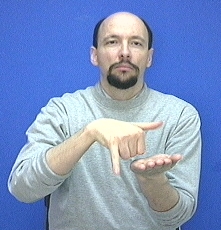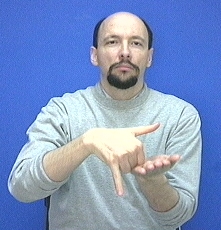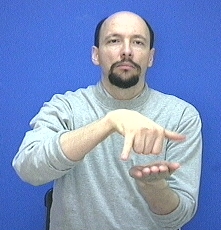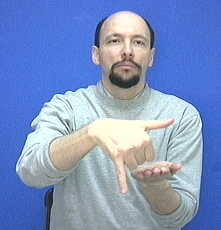American Sign Language: "waddle"
In ASL the "Y" handshape is occasionally used to show that something is "wide."
For example, the "Y" hand can be used to show a fat person walking.
The sign "waddle" rocks side to side as it moves forward. It can be used either to show a fat person (or animal) walking or it can be used as a derogatory "insult" to indicate that you think someone is "obese" or "so fat that they waddle."
WADDLE:
See: FAT
Notes:
Question: A student asks: Understanding that ASL in an expressive language related to but different from English, how is the "obese person waddling" sign/expression used in a non derogatory or harmless manner? Thanks.
Answer:
What an excellent question!
Context, relationship, facial expression, intent, and other things like the reality of the situation all influence how a sign is perceived.
By "reality of the situation" I mean literally what is the reality -- is the person actually obese or are they skinny but complaining about "feeling" fat? Using a sign in an obviously "not describing reality" manner influences how others perceive the meaning of the sign.
We we can use a neutral facial expression if we just want to state in a neutral manner the fact that someone is waddling.
An example of the "Y"-hand classifier / sign not being derogatory or harmful would be to use it in describing a Sumo wrestling situation. You could modify the facial expression and use more forceful movements and create a "thunderous" type of walking (or thundering forward) by a massive Sumo wrestler thus the sign would actually be complimentary.
Another example of a non-harmful usage of this sign would be to use a neutral (or whatever sentiment you wish to convey) facial expression while using this sign to describe a penguin waddling from one place to another.
An aspect to consider is that Hearing and Deaf culture are different. To whatever extent you already knew that -- forgive me, I've got a wide readership and perhaps some other reader might benefit from reflecting on the idea that what is considered derogatory in one culture might be fairly standard in some other culture.
In the Deaf world we use the term "Deaf blunt" to proudly note that we are often more blunt in our communication and that true / actual Deaf bluntness isn't offensive to other Deaf blunt people. Sure, there are Deaf jerks in the Deaf world -- just as there are Hearing jerks. "Deaf blunt" isn't a free pass to be a jerk but rather a cultural approach to being direct in our description of things we see.
For example, I had a roommate (Deaf) back when I had hair on my scalp. He and I were "buds." He moved away and I moved away but after a few years we met up at a conference and two things happened right away when we saw each other:
1. We gave each other a big hug.
2. He then signed, WOW! YOU BALD!
(Excuse the caps, in ASL writings we tend to capitalize signs.)
What constitutes rudeness can and does vary from person to person but I think it would be generally accurate to claim that in Hearing culture my former roommate's comment would likely be considered rude.
From the Deaf culture lens though -- he was simply being "Deaf blunt." I took absolutely zero offense. None. Why? Because he was stating an obvious yet to him momentarily "shocking" fact. We then proceeded to have a great conversation and hugged again at the end of the conversation.
Another example is if you have bad breath and come within smelling distance of a native Deaf individual who grew up "in the culture" chances are you are going to be informed of the status of your breath. You can take offense if you choose but chances are no offense was intended. It is more likely that you will be offered a mint or piece of gum if the person has a spare and (again if you choose) you can go on and have a wonderful conversation.
I could likely go on at length discussing this but I'll just mention this next point and then I need to focus on various local projects -- the point being: Some signs might be best be placed in a person's receptive vocabulary (metaphorical) "toolbox" and not placed in a person's active usage expressive vocabulary. In other words, it is good for ASL interpreters to be able to recognize a wide range of signing (offensive or not) even if they don't personally tend to use certain words or signs in their daily conversations.
Want to help support
ASL University? It's easy:
DONATE (Thanks!)
(You don't need a PayPal account. Just look for the credit card
logos and click continue.)
For a list of various ways to donate see:
https://www.Lifeprint.com/donate
Another way to help is to buy something from the ASLU "Bookstore."
Want even more ASL resources? Visit the "ASL Training Center!" (low
cost / high quality courses)
CHECK IT OUT >
A must see!:
ASL University's YouTube playlist ►
You can learn
American Sign
Language (ASL) online at American Sign Language University ™
Lifeprint.com © Dr. William Vicars






